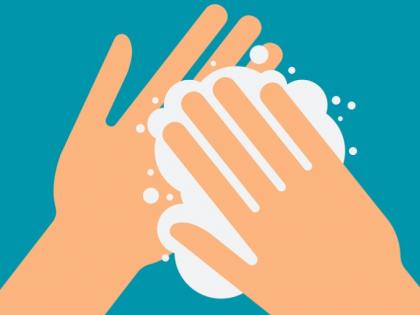Global Hand Washing Day: How has the pandemic led behavioral change
By Lokmat English Desk | Published: October 15, 2020 05:00 PM2020-10-15T17:00:36+5:302020-10-15T17:01:03+5:30
October 15 is global hand hygiene day. On this occasion we will go through the science behind maintaining hand ...

Global Hand Washing Day: How has the pandemic led behavioral change
October 15 is global hand hygiene day. On this occasion we will go through the science behind maintaining hand hygiene and also discuss whether the ongoing pandemic has influenced the behavior for hand hygiene.
Why is the Government advising us to wash our hands?
Coronavirus is a respiratory illness, meaning it is mostly spread through virus-laden droplets from coughs and sneezes. If you don’t catch your coughs and sneezes in a tissue and safely dispose of it, the virus can end up on surfaces. If someone else touches that contaminated surface, the virus can transfer onto their hand. If you have the virus on your hands, you can infect yourself by touching your eyes, mouth or nose. You might think that you don’t touch your face very often, but it’s much more than you realize. A 2015 study found that people touch their faces an average of 23 times an hour.
While washing your hands is useful in preventing yourself from getting infected, this is not the main reason the Government recommends it. The main reason to promote handwashing is to stop spread of infection in the community. This cannot be achieved without support from public. Now that we have established importance of hand hygiene, we will discuss if the ongoing pandemic has led to any behavioral changes in the same.
I tried to search literature or published articles on this but found only handful of data. I found an article in American journal of infection control by Lori D Moore et al. these researchers installed automated hand hygiene monitoring systems in 74 adult inpatient units in 7 hospitals and 10 pediatric inpatient units in two children’s’ hospitals. They noted that average hand hygiene practice rates in these hospitals improved from 46% to 56 % and peaked at 60% at onset on school closure in USA. However the improvement in rates was transient and later decreased to 54% by end of study. Significant increase in hand hygiene rates was due to increased emphasis on hand hygiene by govt authorities, significant decrease in work load in initial time, heightened perception of risk for health care workers and their families. As the pandemic progressed, several factors played role for drop in rates of hand hygiene practice. These include increase in work load and opportunities for performance of hand hygiene practice, concerns over limited supply of hand hygiene products, use of gloves in lieu of hand hygiene and less frequent direct observation/reminders from nurse managers and infection prevention leaders due to competing pandemic related priorities.
One more interesting survey by Prashansha Gupta is worth noting. She conducted an online survey with 211 respondents from north India. she had asked three questions. The first question asked was – How the handwashing practices at critical times has changed pre-COVID-19 and during COVID-19 pandemic times after one month since the outbreak? The main findings on this question were that even though there has been a massive increase ( up to 60%) in overall hand washers with soap at different occasions, the time when they think safe hand washing is necessary to fight COVID-19 risk is largely perception-based creating a lower level of confidence on the sustainability of behaviour change related to safe hand washing. The second question asked to respondents was- How much is the time taken on average in each hand washing has changed during Pre-COVID-19 and during COVID-19 pandemic times after of one month since the outbreak? The key finding was that even though in general there is an increase of timing for handwashing to make it safer, , 60% of the people are washing hands with soap within 20 seconds of prescribed minimum time essential to complete safely six steps of safe hand washing. They continue to remain at 100% risk of catching the infection from their hands despite their, so-called, safe Hand Washing with soap. The third question asked to respondents was -Has there been some change in the items which people use for safe hand washing Pre COVID and during COVID pandemic times? There has been a phenomenal increase ( 29% to 66%) in percentage of people using Hand Sanitizers and liquid soap remains most popular option ( 94% people use it). The drastic increase in percentage of people ( by 37%) adopting to hand sanitizers seems to be picking up as an alternative to safe hand washing through soap and clean water. However, remember that sanitizers are an option only when soap and clean water are not available for safe hand washing such as while travelling. It does not matter if you use a normal soap or germicidal soap/ sanitizer/ liquid hand wash or a normal one. Both the above studies tell us that the improvement in performance of hand hygiene is transient and also the public should be educated about which items to use for hand hygiene. Hand wash is the cheapest and simplest measure to prevent spread of infection and should be practiced by everyone. In this pandemic, when we lack definitive therapies and vaccines, hand hygiene alone can go long way in keeping you safe from getting infected. To sustain a positive behavioral change, community awareness and reiteration on importance of hand hygiene is imperative.
The article is written by Dr. Varun Deshmukh, Chief Intensivist Critical Care Medicine, Jaslok Hospital & Research Centre
Open in app